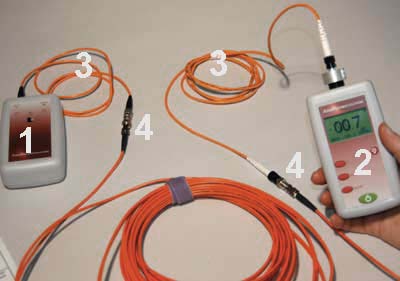Advanced Optical Fibre Testing Equipment for Consistent Analysis
Advanced Optical Fibre Testing Equipment for Consistent Analysis
Blog Article
Crucial Functions to Search For in Optical Fiber Testing Tools
When examining optical fibre testing equipment, numerous vital features warrant cautious factor to consider to make sure optimum performance and integrity. Compatibility with existing market standards enhances functionality, while advanced dimension capacities, consisting of TDR and OTDR testing, offer vital insights into network integrity. Comprehending these functions will certainly lose light on just how to choose the best tools for your certain needs.
Accuracy and Precision
Precision and accuracy are important criteria in the examination of optical fiber testing tools. These 2 qualities guarantee that measurements mirror the real efficiency of fiber optic systems, which is crucial for reliable network setup, maintenance, and troubleshooting. Accuracy refers to the nearness of a measured worth to the actual value, while accuracy signifies the repeatability of measurements under unchanged problems.
When selecting optical fiber screening equipment, it is necessary to think about instruments that give high accuracy and precision to reduce errors in information analysis. Instruments such as optical time-domain reflectometers (OTDRs) and power meters ought to have calibration mechanisms to guarantee consistent performance gradually. Furthermore, the specifications offered by makers need to detail the tools's measurement uncertainty, which directly influences the reliability of examination results.
Moreover, the efficiency of optical fiber screening equipment can be affected by ecological variables, such as temperature level and humidity. For that reason, picking devices developed to mitigate these variables will certainly boost measurement integrity. To conclude, purchasing optical fiber screening tools with robust accuracy and precision attributes is basic for maintaining ideal network performance and ensuring the integrity of fibre optic communications.

User-Friendly Interface
The effectiveness of optical fiber testing devices is not entirely determined by its precision and precision; a straightforward user interface plays a substantial duty in enhancing operational efficiency. A well-designed user interface streamlines the communication in between the specialist and the devices, enabling an extra intuitive understanding of complex functions.
Key attributes of a straightforward user interface include clear navigating menus, logical formats, and easily accessible controls. These elements make it possible for service technicians to do examinations quickly without comprehensive training, lowering the chance of customer error - ofda. In addition, visual indicators such as development bars, alerts, and graphical representations of data can considerably enhance the user experience by providing prompt responses on the testing procedure.
Furthermore, personalized settings can additionally enhance procedures by permitting individuals to change specifications according to particular screening demands. This versatility not just conserves time but additionally makes certain that the equipment satisfies varied application requirements.
Integrating assistance functions, such as tooltips and thorough manuals, into the interface can further empower users, advertising self-sufficiency and self-confidence in operating the tools. Inevitably, an easy to use interface is essential for optimizing the capacity of optical fiber screening devices, resulting in a lot more efficient and reliable testing outcomes.
Portability and Longevity
Mobility and toughness are vital qualities of optical fibre screening devices, making sure that it can hold up against the roughness of numerous atmospheres while staying easy navigate here to transport. Professionals frequently operate in varied setups, from telecommunications centers to remote installations, making it critical that screening tools are lightweight and compact (ofda). Devices created with mobility in mind generally includes ergonomic deals with and instances that assist in simple and easy activity, hence enhancing operational efficiency on-site
Sturdiness is similarly necessary, as optical fibre testing tools is commonly subjected to harsh conditions, consisting of temperature variations, wetness, and physical effects. Devices built with tough materials such as strengthened plastics or metal real estates are better matched for these atmospheres, reducing the risk of damage during usage and transport. Furthermore, devices with water and dust resistance rankings, such as IP ratings, makes sure trustworthy efficiency click this link in difficult conditions.
Compatibility With Specifications
Making certain compatibility with sector standards is essential for optical fibre screening tools, as it directly influences the dependability and validity of examination outcomes. Optical fibre networks go through rigid efficiency standards developed by different companies, consisting of the Telecommunications Sector Association (TIA) and the International Electrotechnical Compensation (IEC) Testing devices needs to comply with these criteria to make certain that dimensions are constant and comparable throughout different systems and settings.
When picking optical fiber testing devices, customers need to confirm that the device meets pertinent requirements pertinent to their details application, such as those associated to depletion, data transfer, and crosstalk. Equipment that is compliant with well established criteria not just aids in accomplishing precise results but additionally assists in interoperability amongst devices from various producers.
Furthermore, compatibility with requirements ensures that the equipment can be used in governing compliance situations, which is critical for projects in sectors such as telecommunications, aerospace, and army applications. Consequently, buying optical fibre testing devices that aligns with existing sector requirements is a basic element of keeping quality control and accomplishing optimum network efficiency.
Advanced Dimension Capacities
Advanced dimension capacities are a defining feature of modern optical fibre testing tools, permitting extensive evaluation of network performance. These capacities guarantee that specialists can assess important criteria such as signal loss, dispersion, and bandwidth, which are important for maintaining optimum communication effectiveness.
One secret element is the capacity to perform time-domain reflectometry (TDR) and optical time-domain reflectometry (OTDR) tests. These methods enable individuals to identify faults, measure the size of fibres, and identify the place of flaws with exceptional accuracy - ofda. Moreover, sophisticated tools frequently includes the capacity to determine optical power levels, aiding to examine the total health and wellness of the network and make certain compliance with the required requirements.
In addition, some testing gadgets offer advanced algorithms for real-time evaluation, enabling quicker medical diagnosis and troubleshooting. In verdict, investing in optical fibre testing devices with innovative measurement capabilities is important for making sure network reliability and efficiency in today's requiring telecommunications landscape.
Verdict

Report this page